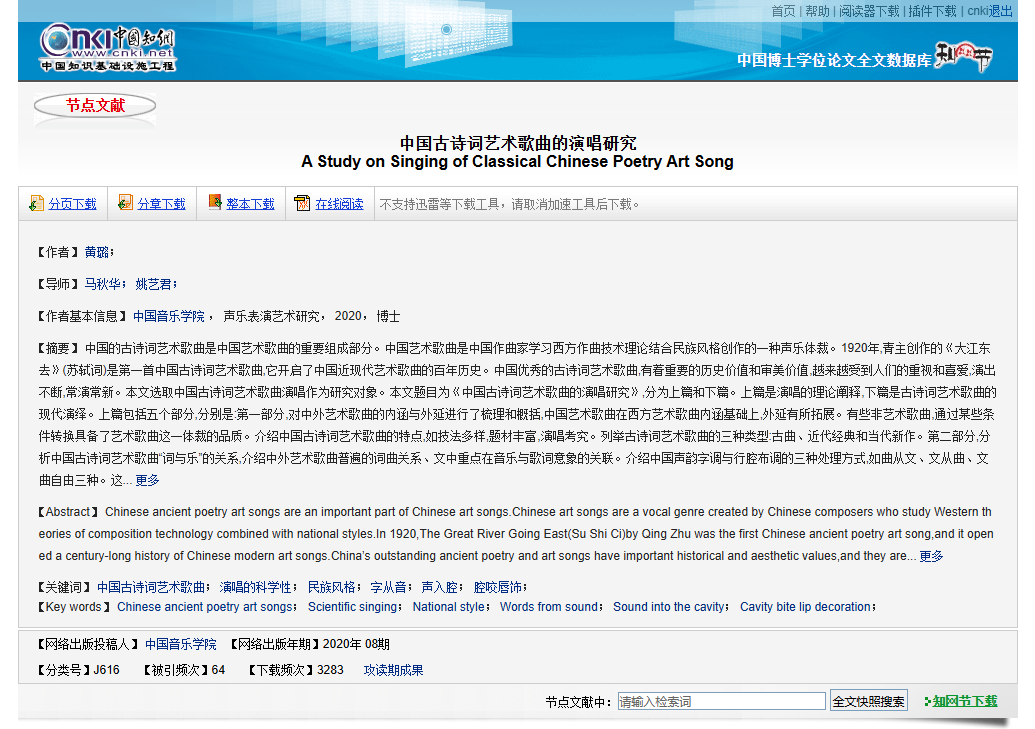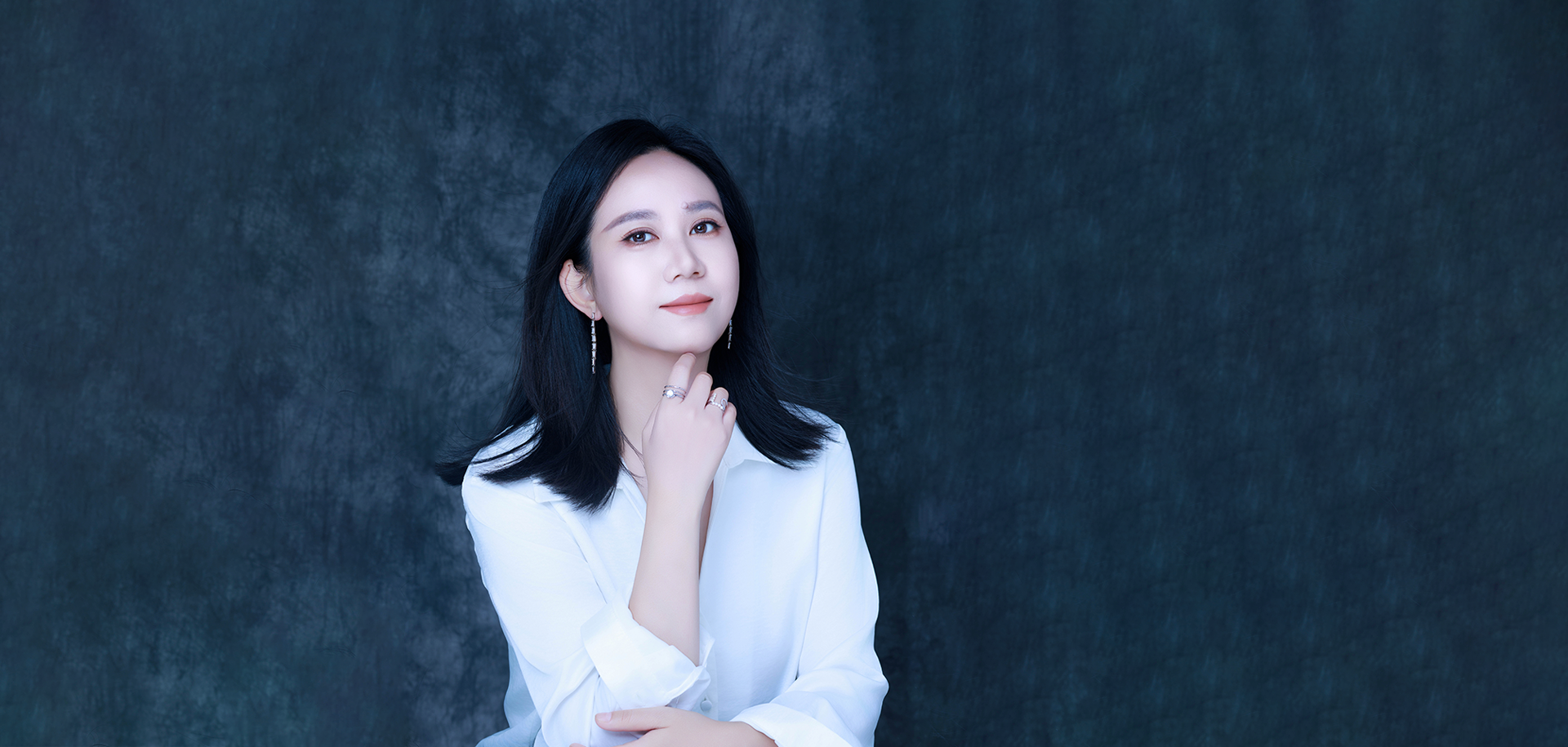
SHOW

SHOW
A Study on Singing of Classical Chinese Poetry Art Song
15:14 Jan 01 1969
[Author]: Huang Lu;
[Supervisor]:Ma Qiuhua; Yao Yijun;
[Author's basic information]: China Conservatory of Music , Vocal Performance Art Research, 2020, Ph.
[Abstract]:
Chinese ancient poetry art songs are an important part of Chinese art songs.Chinese art songs are a vocal genre created by Chinese composers who study Western theories of composition technology combined with national styles.In 1920,The Great River Going East(Su Shi Ci)by Qing Zhu was the first Chinese ancient poetry art song,and it opened a century-long history of Chinese modern art songs.China’s outstanding ancient poetry and art songs have important historical and aesthetic values,and they are more and more valued and loved by people.Their performances are constant and new.This article selects the singing of Chinese ancient poetry art songs as the research object.The title of this article is the singing study of Chinese ancient poetry art songs.The first part is a theoretical explanation of singing,and the second part is a modern interpretation.The first part consists of five parts:In the first part,the connotation and extension of Chinese and foreign art songs are summarized and summarized.Chinese art songs have been extended based on the connotations of Western art songs.Some non-art songs have the genre of art songs through certain conditions.Quality.Introduce the characteristics of Chinese ancient poetry art songs,such as diverse techniques,rich themes,and elegant singing.Three types include ancient songs,modern classics,and contemporary new works.The second part analyzes the relationship between lyrics and music of Chinese ancient poetry art songs,and introduces the general relationship between Chinese and foreign art songs.The emphasis is on the relationship between music and lyrics imagery.This paper introduces three processing methods of Chinese rhyme and tone,such as Qu Congwen,Wen Cong Qu,and Wen Qu Freedom.This part also discusses how Chinese ancient poetry and art songs are processed through singing,such as the artistic endowment of section songs,or the processing of gas and mouth connections,etc.,through reasonable singing processing,to convey lyrics,shape images,and reproduce moods.The third part explores the relationship between singing style and style of Chinese ancient poetry art songs.These include scientific singing,national style,and a combination of the two.Scientific singing includes introduction of vocal cord closure,breathing resonance,and so on.The national style includes the introduction of the meaning of the word,the tone of the rhyme,the tone of the word,and the tone of the word.It discusses that the singing of Chinese ancient poetry and art songs should not only have the scientific nature of singing,but also the style of Chinese nation.It is pointed out that the organic combination of singing and style is thedirection that the Chinese vocal school should establish.In the fourth part,new ideas of Chinese ancient poetry art songs are put forward.On the basis of summing up the academic research and singing experience of the predecessors,and combining with their own singing practice,this article puts forward and discusses the singing principles of Chinese ancient poetry art songs.Summarized as "characters from the sound,sound into the cavity,cavity bite lip decoration."The word Congyin emphasizes that the singing must follow the music score and pay attention to the intonation;the sound enters the cavity,which emphasizes the resonance of the pharyngeal cavity,and pays attention to the professionalism of modern vocal music;And modification to achieve accurate,clear,complete and full Chinese characters.The fifth part,based on the "Huang Lu Chinese Art Songs Tour of 100 Schools" as a practical basis,combined with my performance and communication,discusses the current spread value of Chinese ancient poetry and art songs,including the response of different audiences,sound effects of different theaters,and Attempts of various performance forms.The modern interpretation of the next part divides Chinese ancient poetry and art songs into three types: ancient songs,modern classics,and contemporary new works.Each type has three selected songs.The selected works are both vocal teaching repertoires and are often performed on the stage.There are many singing versions of singers left.The selected singing version is also a representative singer,some have died,and some are well-known singers who are active on the domestic or international stage.It also includes world famous foreign songwriters.The singing version used for comparison involves different genders,different singing methods,different voices,different treatments,and also includes uncommon tenor.These singers’ editions are used for appreciation,as a paradigm,to show the various presentation methods and deductive characteristics of Chinese ancient poetry art songs.At the same time,they have jointly formed some new features of modern interpretation of Chinese ancient poetry art songs.For example,scientific vocalization methods,clear articulation and spitting,focusing on the expression of the lyrics and artistic conception,and individualized vocal performances.Ancient songs include "Three Stacks of Yangguan","Apricot Blossom Shadow" and "Old Fisherman".The singing version is selected by Guo Shuzhen,Jiang Jiazhen,Zhang Liping,Lei Jia.Recently,the classics are selected,including the master’s "Going to the East","I Live on the Yangtze River" and Huang Zi’s "Dianjiangchun· Fudenglou".,Shen Yang,Shi Yijie singing version of seven singers.New contemporary works include Ao Changqun’s "Jiang Chengzi",Zhou Yi’s "Chai toufeng",and Zhao Jiping’s "Guan Ju".The singing version selected Fang Qiong,He Leiming,Liao Changyong,Li Xiuying,Xiao Ma,and Shi Yijie.Singing version of home.Each piece includes a work analysis and singing comparison.Analysis of works,including modern translation of ancient poems,introduction of songwriters,and analysis of musical works.Singing comparison,including the introduction of singers,singing treatment of singers,singing characteristics of singers.The next part not only analyzes and compares the works.It also summarizes and summarizes the contemporary interpretation of Chinese ancient poetry art songs.
[Key words]:Chinese ancient poetry art songs; Scientific singing; National style; Words from sound; Sound into the cavity; Cavity bite lip decoration
[Web Publishing Contributor]: China Conservatory of Music

